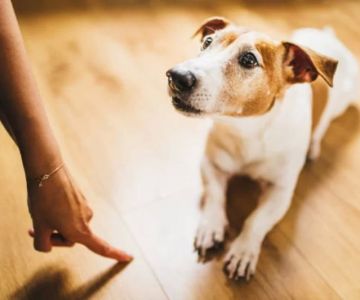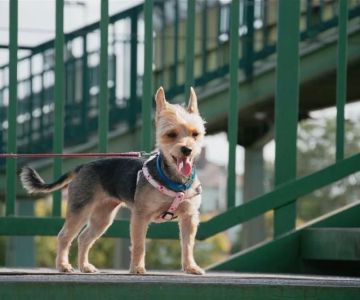- 1-how-to-train-dogs-to-ignore-distractions
- 2-understanding-why-dogs-get-distracted
- 3-step-by-step-training-methods-to-build-focus
- 4-real-case-studies-and-common-challenges
- 5-tools-and-environments-for-successful-focus-training
- 6-long-term-maintenance-tips-and-guidance-from-hidden-brook-veterinary
1. How to Train Dogs to Ignore Distractions
Every dog owner has faced it: your dog spots another animal, a passing jogger, or even a fluttering leaf—and suddenly forgets every command you ever taught. Teaching your dog to stay calm and focused in distracting environments is one of the most rewarding skills you can develop. This guide will walk you through proven methods on how to train dogs to ignore distractions while building trust and better communication between you and your pet.
Training a dog to stay attentive isn’t about forcing obedience; it’s about teaching self-control and reinforcing positive focus. Whether you’re working with a hyperactive puppy or a reactive adult dog, consistency and patience are the key. If you need personalized advice or professional training support, Hidden Brook Veterinary provides expert resources and behavior consultations tailored to your dog’s unique temperament.
2. Understanding Why Dogs Get Distracted
2.1 Natural Instincts and Environment
Dogs are naturally curious. Scents, sounds, and movement trigger their hunting or social instincts. A squirrel darting across the yard or a new smell on the trail can easily override your voice command. Recognizing these natural impulses helps you train with empathy rather than frustration.
2.2 Emotional Triggers and Energy Levels
Stress, excitement, or lack of physical exercise can also lead to distraction. A bored or under-stimulated dog is more likely to fixate on external triggers. Ensuring your dog has adequate daily exercise and mental stimulation reduces restlessness and improves their focus during training sessions.
2.3 Human Influence
Dogs mirror human energy. If you’re impatient or inconsistent, they’ll pick up on that confusion. Calm, confident communication sets the foundation for reliable obedience. Remember: you’re not just teaching commands—you’re shaping attention habits.
3. Step-by-Step Training Methods to Build Focus
3.1 Start with a Low-Distraction Environment
Begin training in a quiet area—like your living room or backyard. Use a leash and plenty of treats. Practice simple commands such as “sit,” “stay,” and “look at me.” The goal is to associate obedience with rewards before distractions enter the picture.
3.2 Introduce Controlled Distractions
Gradually increase difficulty by adding mild distractions: turn on the TV, drop a toy, or have a family member walk by. If your dog loses focus, calmly guide them back to the task and reward when they re-engage. Repetition builds resilience.
3.3 Practice the “Focus” or “Watch Me” Cue
Hold a treat near your face and say, “Watch me.” When your dog makes eye contact, mark the behavior with a click or “yes!” and reward immediately. This exercise teaches them that looking at you is more rewarding than reacting to distractions.
3.4 Leash Training Around Movement
Once your dog masters indoor focus, move to outdoor sessions. Use a short leash and maintain steady pace control. If your dog lunges or looks away, stop walking. Wait until they look back at you—then reward and resume. Over time, they’ll learn that focus equals progress.
3.5 Positive Reinforcement and Consistency
Always reward good behavior with praise or treats. Avoid punishment—it creates fear rather than understanding. Short, frequent sessions (5–10 minutes) work best, especially for puppies or high-energy breeds. End on a success to build confidence.
4. Real Case Studies and Common Challenges
Case Study: The Reactive Rescue – A client at Hidden Brook Veterinary adopted a rescue dog who barked at every passing car. The trainers began with indoor focus exercises and gradually introduced outdoor sessions near a quiet street. Within two months, the dog could calmly watch cars pass without barking—proof that patience pays off.
Case Study: The Energetic Puppy – A young golden retriever struggled to focus during obedience classes. By incorporating daily fetch sessions and puzzle toys before training, his energy was channeled constructively. His owner reported a “night and day” difference in attentiveness after just three weeks of structured training.
Common issues like fear, excitement, or leash pulling are normal. The secret lies in adjusting your approach—some dogs respond better to food, others to play. Knowing what motivates your dog accelerates learning dramatically.
5. Tools and Environments for Successful Focus Training
5.1 Essential Training Tools
A sturdy leash, clicker, and small bite-size treats are must-haves. For reactive dogs, a front-clip harness offers better control without strain. Avoid choke collars or retractable leashes—they can undermine consistency and create tension.
5.2 The Role of Environment
Start in calm areas, then transition to moderate environments like local parks. Keep sessions short and finish before your dog loses interest. When ready, challenge them in busier settings—farmers’ markets, trails, or near other dogs—always rewarding calm behavior.
5.3 Professional Support When Needed
If your dog struggles with aggression or fear-based distractions, consult professionals. Behaviorists or certified trainers affiliated with Hidden Brook Veterinary can develop a customized plan based on your pet’s needs. Expert supervision ensures safe progress and long-term behavioral improvement.
6. Long-Term Maintenance Tips and Guidance from Hidden Brook Veterinary
6.1 Consistency Beyond Training Sessions
Dogs thrive on repetition and structure. Reinforce focus exercises during daily walks or playtime. Keep commands consistent among family members to prevent confusion. The more you integrate focus practice into daily life, the stronger your dog’s self-control becomes.
6.2 Reward Calmness in Real Life
Notice moments when your dog naturally ignores distractions—reward those too. If they choose to look at you instead of barking at another dog, praise them instantly. This spontaneous reinforcement builds real-world obedience faster than formal sessions alone.
6.3 Continued Learning and Community
Training doesn’t end once your dog learns basic focus—it’s an ongoing journey. Participate in obedience refreshers, dog park meetups, or structured playgroups to maintain progress. For specialized behavior advice or training supplies, visit Hidden Brook Veterinary where pet experts can help match you with the right tools and guidance for your dog’s next milestone.
Mastering how to train dogs to ignore distractions isn’t just about commands—it’s about trust, patience, and consistency. With the right strategy and expert support from Hidden Brook Veterinary, you can transform your walks, strengthen your bond, and enjoy a calmer, happier dog in any environment.










